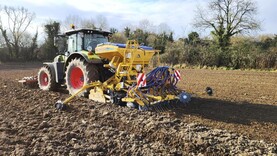This harvest was always going to be different.
Because of the steadily rising prices over the past year, I have been nibbling away at forward selling grain, with the result that 70% of our budgeted wheat crop had been sold before the harvest began.
But it hasn’t been the year for forward selling.
About half of what we sold was at a lower price than the market returns today.
Thankfully, the rest is OK, but grain prices are very firm and right at this moment, I’d be happier if I had less forward sold.
Normally, I do a little better than I have this year, but forward selling is not without its risks
However, these things can so easily change without warning. Such is the way of the open and free market world. It only takes a slight policy change in Putin’s Russia or a report of a promising harvest in central Europe to send the speculators into overdrive or freefall.
Normally, I do a little better than I have this year, but forward selling is not without its risks. They say the top and bottom of the market are for fools and forward selling protects you against this ignominy.
It has, in the past, served us quite well, but I’m not entirely convinced that it has its place. But it is insurance that gives a degree of certainty.
This year, we had just one field of winter oilseed rape (variety Ambassador) which, you may recall, I have maligned since its sowing with a Claydon drill last September.
By St Patrick’s Day, there was hardly any greenery left
A second field never got going and was replanted with winter wheat. The remaining rape crop got off to a very bad (and late) start, which the pigeons (and slugs) took advantage of and decimated the crop.
By St Patrick’s Day, there was hardly any greenery left. Nonetheless, I puked on the nitrogen and the crop began to improve. Last Friday, we took 1.80t/ac off Darbys and sold it at last week’s dried price of €505/t, which was nice. I hadn’t forward sold it, as the crop yield was too uncertain to call. If I had, I doubt it would have been at this price.
In fairness to the Claydon drill, the plants did develop a good root system, which clearly stood to the crop, and the variety Ambassador has huge yield potential.
It also has the pod shatter resistance gene, which is my first requirement in selecting a winter oilseed rape variety. I have no faith in the spray-on pod sealers, but every confidence in varietal resistance to pod shatter. The winter barley fields have been cultivated in preparation for sowing the new oilseed rape crop.
We have made a start on the wheat (Graham) and it looks promising
It’s great to get a good flush of volunteer barley out of the way before sowing and it’s happening this year. I’ll sow the rape in the last week of August. We’ve also spread farmyard manure onto some of the stubbles.
We have made a start on the wheat (Graham) and it looks promising. Yields so far are around 4.60t/ac – more than I budgeted for – coming off at 20% moisture, which I’m happy with. But it’s early days yet and it is overall averages that count. Huge volumes of straw mean slower combining.
With that said, I’m well pleased with the 2017 25 foot Claas Lexion 670TT combine we bought this year. It’s a major improvement over its 2012 Lexion predecessor.
It doesn’t have the tried and tested frogmouth sieves, but the much newer TM ones instead, which are worthwhile and produce a very clean sample.
The Power Spreader gives an even, full-width straw spread. And the Vario header is magic in rape. With a fair amount of spring rape to cut, it should be a peach this year. Nor is it forward sold.






 This is a subscriber-only article
This is a subscriber-only article










SHARING OPTIONS: